Complete Guide to Walther PP and PPK Magazine Variations for Guns Pre-WW2 and During the War
What is the Proper Magazine that Needs to be with my Gun you Ask?
Hey guys, today I have a very important educational video. It's actually been one I've put off for a while but I absolutely know I need to get done. Because one of the most common questions I get, just beyond what date was this gun made? For Walther PPs and PPKs, again pre-1946 for Walther PPs and PPKs, one of the most common questions I get, what is the proper magazine that needs to be with my gun? And that's the educational video I want to do for you today. It might be a little mundane, usually I like to make you laugh a little bit and tell you a story. This one is strictly business. So let's get down to work and go through all the variations of Walther PP and PPK magazines.
What we will Cover Today
Okay let's get started. You better strap yourself in here, because I have a lot to cover. And let me start off with an introduction. This is actually more like a table of contents, because I just want to tell you, probably the best way to review this video, because I want to go into a lot of detail and you may not need a lot of this detail. So what I want to cover is pre-war PPs and PPKs, the different variations. I also want to cover wartime PP and PPKs, then I want to do a section on box mags if you want to know about that, and then I have specialty mags which would be the different colored mags and magazines used for engraved guns.
I want to talk about the numbered mags which tended to be special-purpose mags and which mags would have been numbered and how would they be numbered. I want to cover 9-millimetre PP and PPK magazines. Also .22 caliber PP and PPK magazines which are probably the hardest to understand, so that one will probably be watched by a lot of people; .25 caliber magazines which are very, very rare. Only a few guns known and so I will show you a 25 caliber mag and the unique part of that. And then finally I'm going to do a how-to video on how to swap out the mag bottom.
How to Navigate This
I tell you all that, because first of all I recommend you watch the video once. But then later on if you just want to see how to take the mag apart you can just fast-forward to that section and I'll put up a blank screen. As I enter each section, I will put up a blank screen and that way you can kind of page through the video, so you don't have to watch the whole thing if you're interested in the .25 caliber mag, you could skip all the way to the end. So this is the table of contents on what I plan to cover.
Section 1 – PRE-WAR
Pre-war Variations of PPs
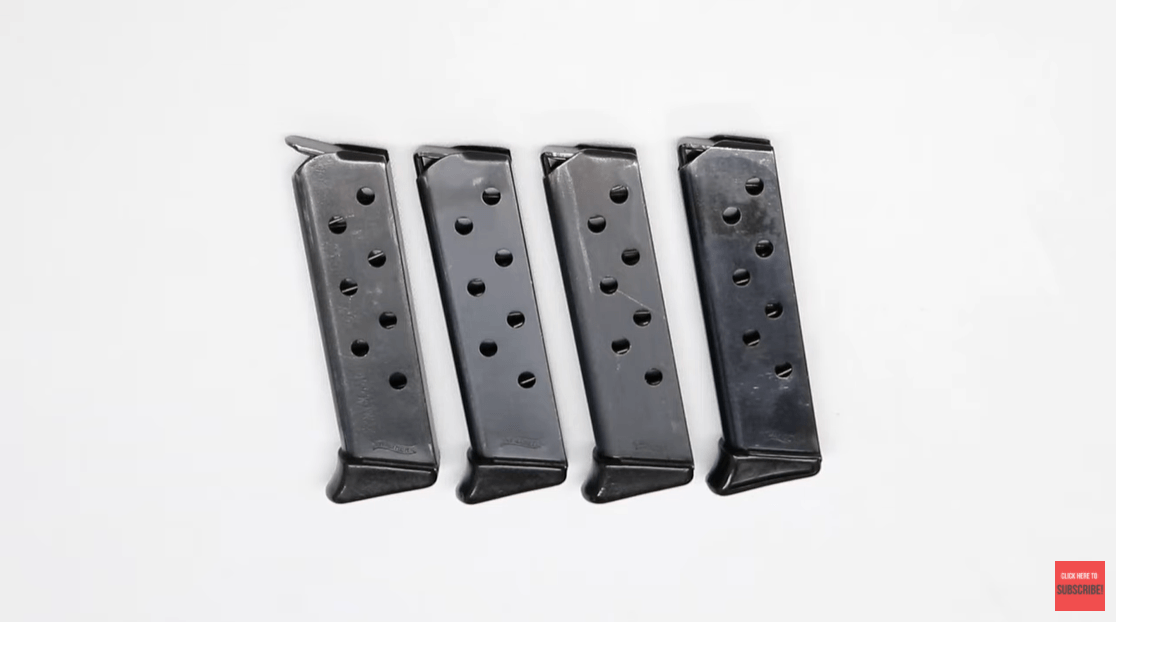
Okay, first section is going to be pre-war PPs, let me go over some variations here. The first variation of pre-war PP is slab bottom with open follower. Now I should start off by saying that all pre-war PPs and PPKs are banner only. Here's what I mean by that. If you look at the very bottom, there it is, you can see it has a Walther banner on it. All pre-war PPs and PPKs, only had the Walther banner.
Let’s look at the Bottoms

Most of them come with a flat bottom like this. So flat bottom, they’re almost always high polish, that's the typical bottom but then they also offer finger extensions both PPs and PPKs. And that's what I want to talk about a little bit here. You can have a flat bottom with an open follower, but more commonly in the early guns a lot of them are bank guns.
The open Follower
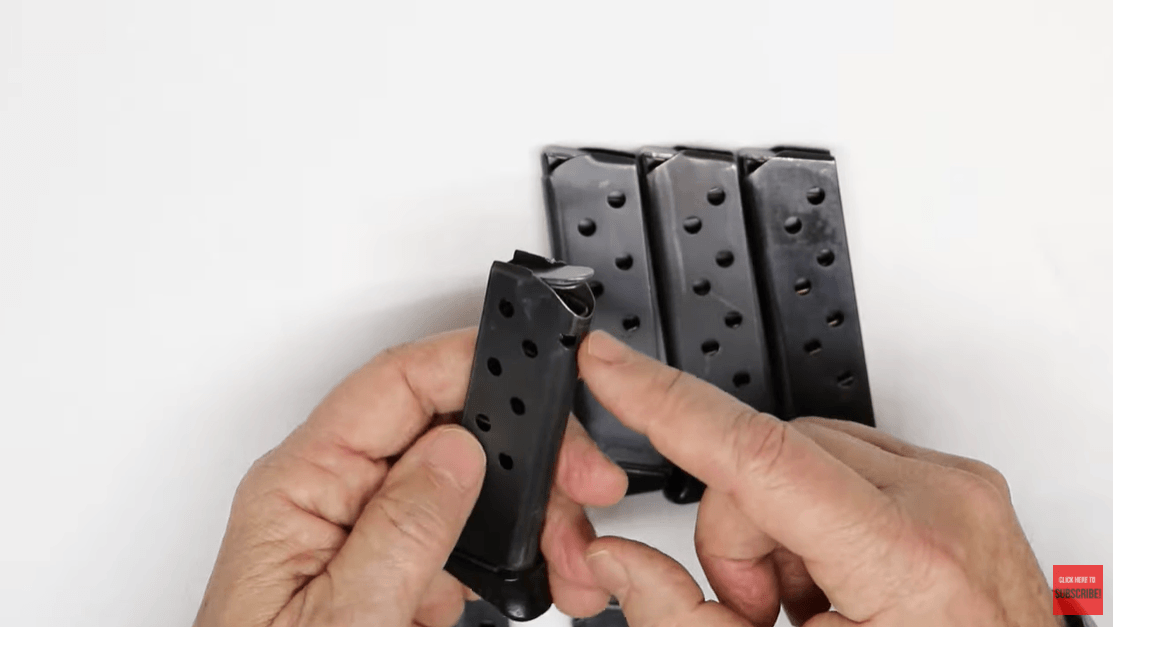
So the bank guns, I'll talk about numbering later, but you can see this is numbered and you probably can't read it but I'm going to read it for you, it's 750127. Now it started at 750,000 so this is the 127th gun made in the Walther Factory that was a PP. So a PP, very early, slab side, open follower. Now the open follower, probably you've never seen one. They’re goofy-looking and it's a very poor design. Because when I go to load it, it gets caught right here; it gets caught and it doesn't work very well. So the open follower only lasted for the first few months.
So this one is within the first hundred or so, and I would say probably within the first three to four hundred, they would have an open follower like this but they got rid of it pretty quickly. So this is a very rare mag with the open follower. The only reason you'd want one is if you are an avid collector and you just wanted one because they're the earliest variation.
Next variation – The closed Follower
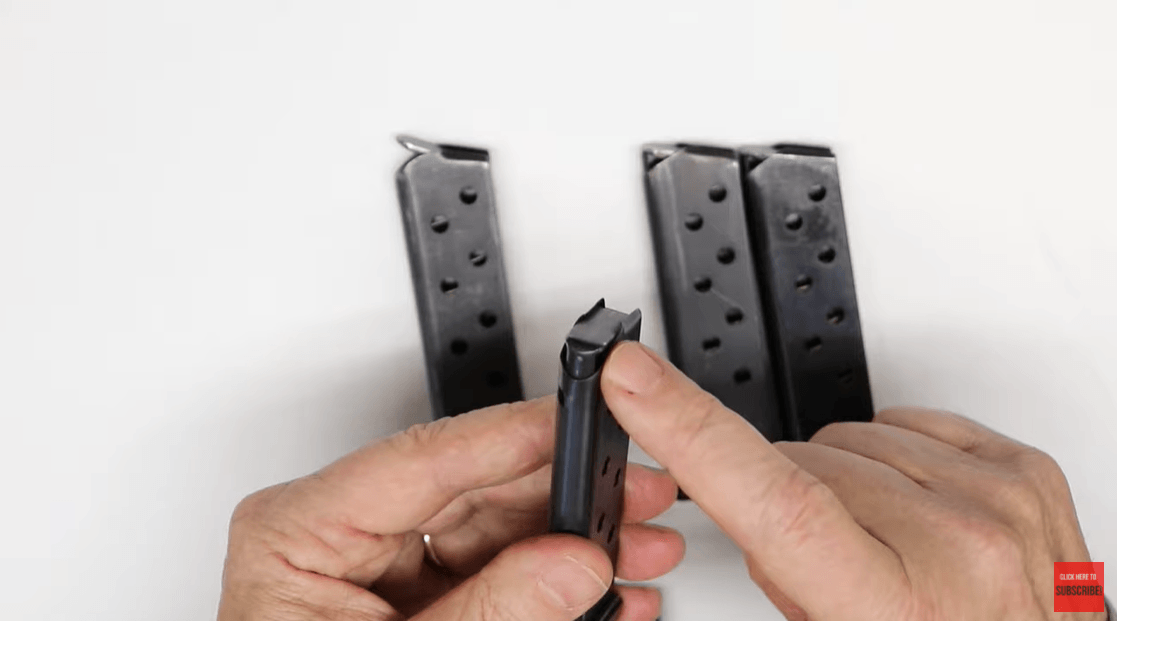
Then very quickly they went to the closed follower. Now the advantage with the closed follower is it feeds a lot easier. So it goes up and down, feeds right in there…the closed follower was the next variation. So this is slab side, no lip we're going to talk a lot about the lip, there's no lip, slab side, no lip, banner only, closed follower. So this is variation one with the open follower, variation two slab side with the closed follower.
A Closer Look at the Finishes
This I just have here, this is also a variation too but I want to show you a little bit about the finishes. The finishes are confusing. I know you think I know everything but I can't really answer this question because what I've found across the board, are some of the earliest PP and PPK magazines are high polish. This one is a high polish mag and this one is just as early but it has like a dull finish to it. I don't know why the difference. Remember the open follower, this is the earliest of the magazines and this one is not that it's not really high polished.
Certainly not as shiny as this one which is a later magazine. So it is confusing, the only thing that I can…if I were forced to explain it, I would say they didn't care…this was considered an internal part, so the external was high polished but they didn't care about the internal so much. The one thing that I know for sure across the board is the bottom of the magazine they were always high polished. I guess if I were a German manufacturer I'd say okay this is the outside of the gun, the exterior finish needs to match, but the inside was not that important. And so my guess is they just used a dull finish for the interior part of the magazine.
The Third Variation
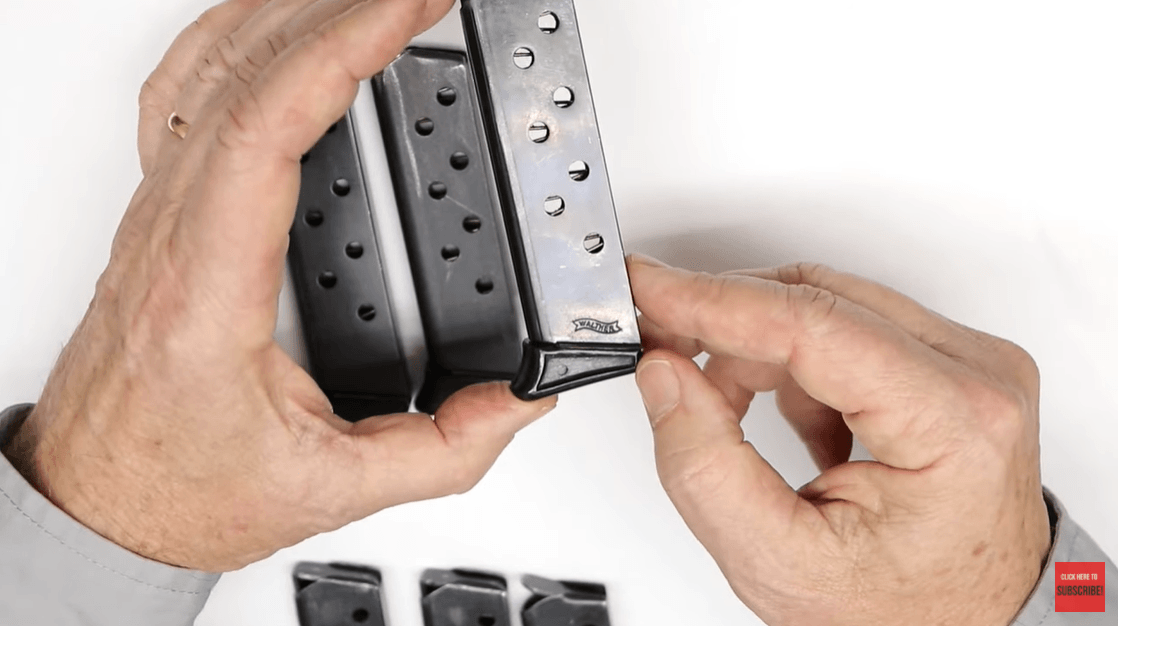
Alright now let me go to the third variation of pre-war. They started indenting. This is what you mostly see. Those of you who collect Walther’s you probably have both PP and PPK that has the indented side and no lip. If you're wondering what the heck am I talking about with the lip, you're going to find out in a minute. So pre-war, the third variation would be indented with no lip.
Last Variation

And then the last variation on pre-war is indented. Notice banner only, all pre-war were banner only, indented thin lip. Let me hold it this way. See the no lip versus the thin lip. This has a thin lip, if I run my finger there, it gets stuck on that thin lip. Now a little later they're going to add some botox and we're going to have a thick lip; but on the pre-war they had no lip, I’m trying to get this better in focus there we go there's some good lighting, pre-war period we have no lip or thin lip.
Over what time Period did these Variations Take Place?
Now what time period are we talking about. If I go to the first variation we're talking about. Oops, out of sequence. If I take a look at each one of these mag bottoms, these first came out in 1929, so the open follower only was produced in the first few months of 1929. And then for a couple of years they did the slab side. So maybe that takes us up to about 1931, ’32. Then they started indenting them in ’33, ’34. And the last of the pre-war were in 1939. So the span is from ‘29 – ‘39 about 10 years. Now this is my word of caution, a lot of collectors obsess about not having the right magazine and they switch them around. But bear in mind that these magazines were just thrown in a bin. They have a bunch of magazines in the bin.
And so let's say its 1938 and we just came out with the thin lip, but in the bin I have a bunch of these old ones and so I'm just reaching in the bin, grabbing a magazine bottom and sticking it on a magazine. So nobody was worried about oh did I get the right lip or not. Did I get a slab side? So you will see variations. My rule of thumb is if it's within one or two variations it's fine; if you're talking about two, three, four variations apart, like you have a gun that was made within the first one hundred and you have a thin lip, then I'd say we can do better than that. But I would not obsess about making sure your magazine was right, I'm just giving you a general rule of thumb. This is 1929 goes all the way up to about 1939 with a thin lip.
Section 2 – WARTIME PP VARIATIONS
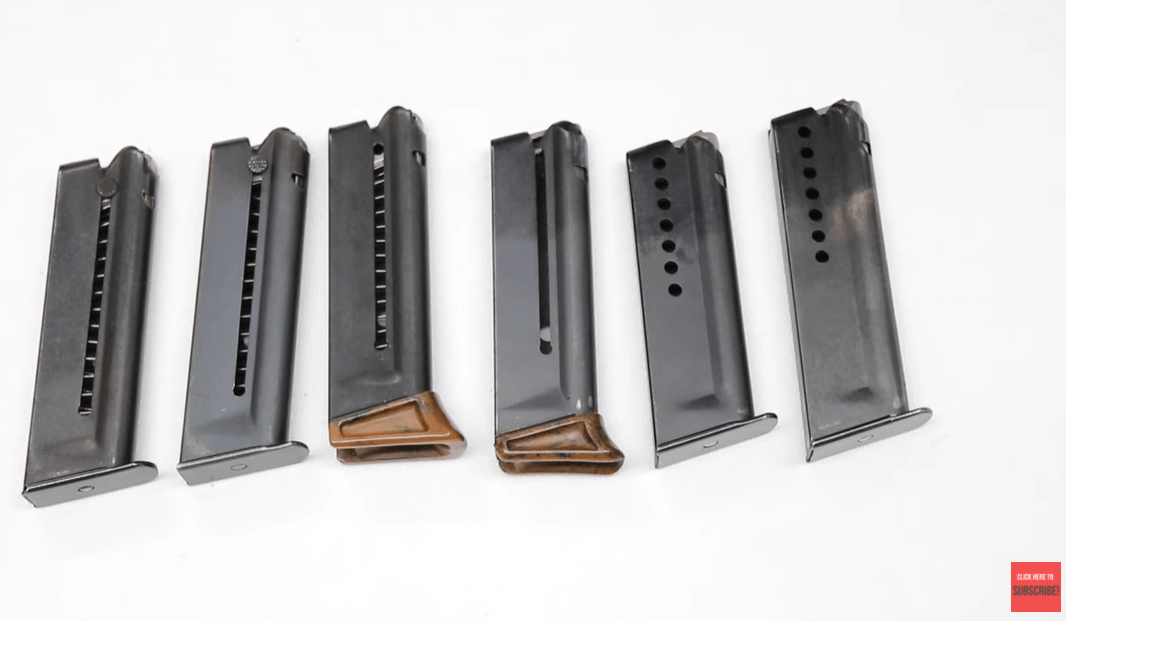
Significant changes to the Magazine
So now we've entered the wartime and they made some significant change on the magazine, in that they have the Walther banner but you'll see that they added the model, you can see that they added the Model PP and the caliber 7.65. This is a very necessary change, because before when it just had a Walther banner I noticed right away that I often make the mistake, that the only way to tell is by holding it like this and I can see this is a PPK and this is a PP, because it's not written on there.
So when the war came along and they had all these magazines stored, I guess some genius came along and said hey let's add the model and the caliber because we don't want to get them confused. So that's what Walther did in around 1940. So the easiest way to remember it is if it's crown N, pre-war, it would have banner only. If it's Eagle N, wartime, it generally should have the model and the caliber.
Don’t get caught up Now
Now again, don't be obsessive about this certainly in 1940 they were still using up the old mags, they didn't throw them away. So you don't have to make sure you’re exact, but if it's 1943, ‘44 certainly by then you should have a wartime magazine. And so here's the variations.
It was really cool to add a Finger Extension
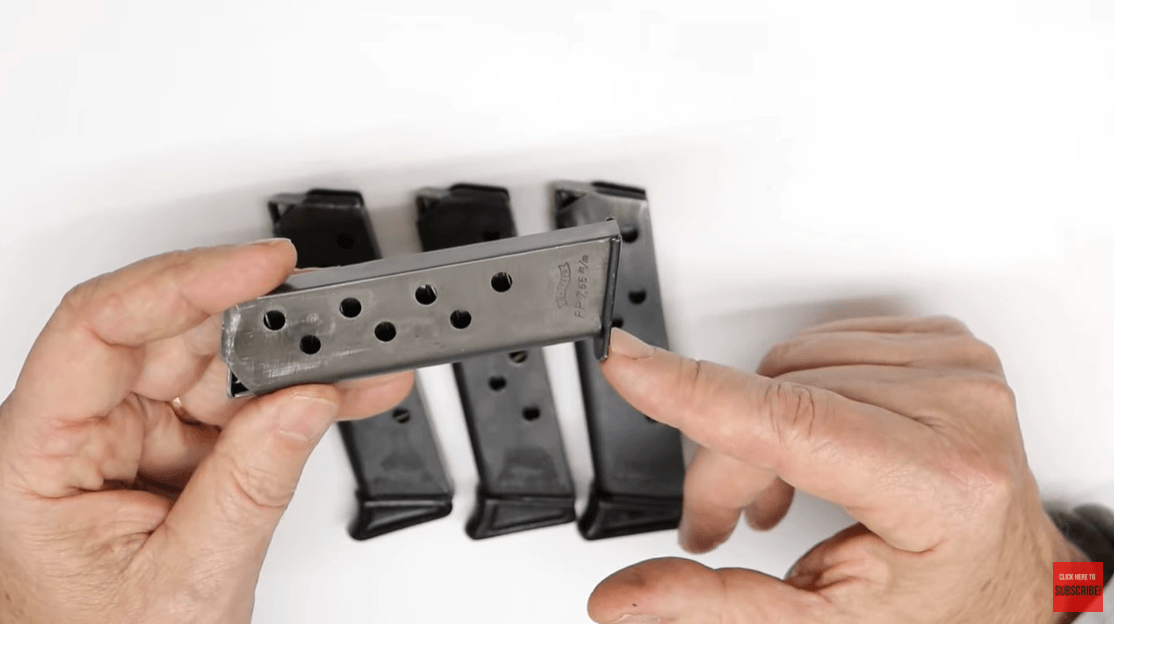
First of all during the war you would have a lot more flat bottoms because these were not being ordered for commercial use. So for many collectors they think it was really cool to add a finger extension because they think it looks nicer. So they take their wartime Waffen proofed gun and they add the finger extension and the army issued guns, they ordered them 500 or 1000 at a time they did not bother with the finger extension. Same way with the police, other than there's a certain police gun the PDM, the Police Department of Munich, they did order them with the finger extension. But most police, and I would say rule of thumb, if it's police or military you should not have a finger extension. So I end up telling collectors stop putting finger extensions on these guns, put them back to a flat bottom.
From Thin Lip Extension to thick Lip Extensions
But let's go over the variations of finger extensions. Now 1940 they still used the thin lip, here's a wartime gun from about 1940. They still had the thin lip. So the thin lip went from 1939 through 1940 and then they added the thick lip. I have no idea why but you could see thin lip, thick lip and then throughout the war up until probably about 1944 they still made thick lip.
They then did away with the Finger Extensions
But my guess is that by 1945 they weren't even bothering with finger extensions, so most late war guns even late ’44, early ‘45 they're all going to be flat bottom, because nobody cared about the little pinky finger.
Now this is a Rare Magazine
This magazine you probably already noticed, this is somewhat rare in that it is a phosphated tube, with a high polish bottom. Phosphate, at the end of the war they were experimenting with phosphate finishes at the Walther Factory, and so this is a rare mag. It's actually worth more because it is a phosphated tube, late-war. This has to be from 1945 because it also has the W, you can see it right there, has the W right there, which means soft metal. They were skipping steps and they actually didn't bother hardening the metal and so this is just marked to say that it's soft metal and it is phosphate. So this is a rare magazine from 1945. So here we span the period of time from about 1940 to about 1945.
Section 3 – PRE-WAR PPK Variations
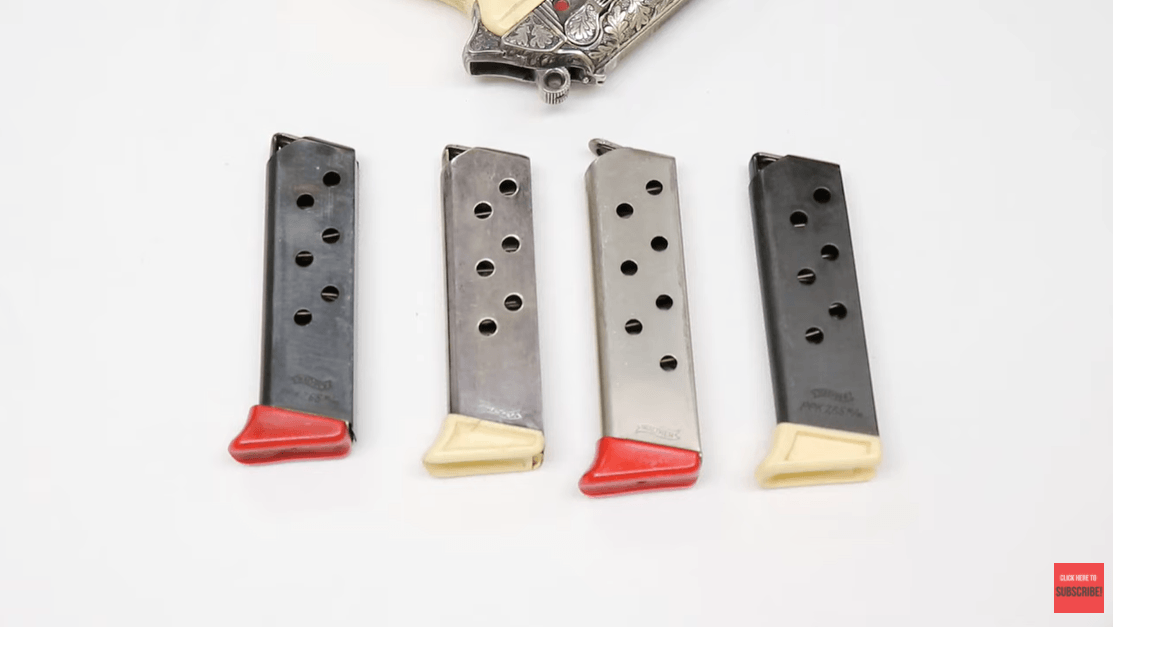
Okay. So you might think well, we're really getting deep in the woods now, but it's going to go a little faster because there's a lot of repeat on the pre-war PPK magazines.
The main Difference is going to be the Finger Extension Bottom
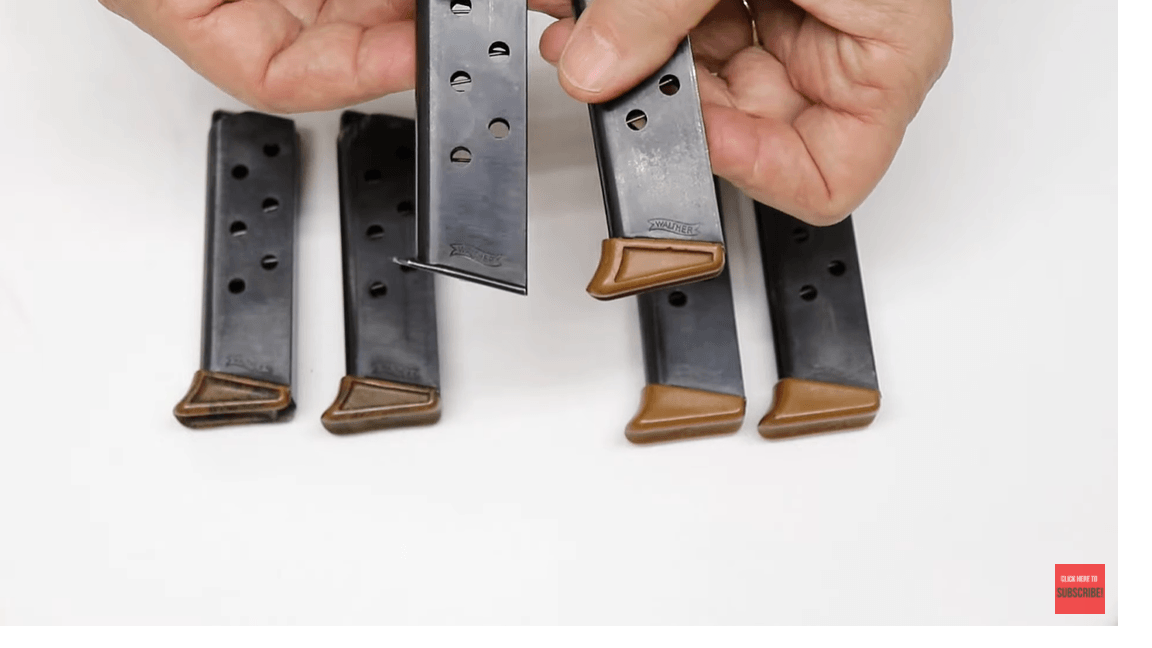
First and foremost they started making PPKs and again this is the standard flat bottom. Most of your magazines are just going to be standard flat bottom. The theory is that every commercial gun came with one flat bottom and one finger extension bottom. We have boxes, I've shown you box guns and usually there's a spare mag. This is in the gun and this is the spare. So I'm just basically talking about the differences in the finger extension bottoms. Now we don't get an open follower because remember this is 1931, it was the first PPK, and 1929 they stopped making that open follower because it was a lousy design.
The First Variation
So the first variation is going to be slab side, remember just like the PP, slab side, no lip and this is a solid color meaning it's not modelled like the grips are modelled, this is not modelled, it's a solid color and that's going to be important as we move along. I'm going to do a whole separate video on the grips, but I just wanted to show you the color.
Next in Line
Okay this next one is similar. Its slab side, no lip but you can see the bank number, this is to a bank gun and the bank arsenal did crudely number them to match the gun. So I just wanted to show you that that was for a bank gun, they're almost always really early and this is an early 771 serial number.
We’re really moving quickly, Next up is the Indented
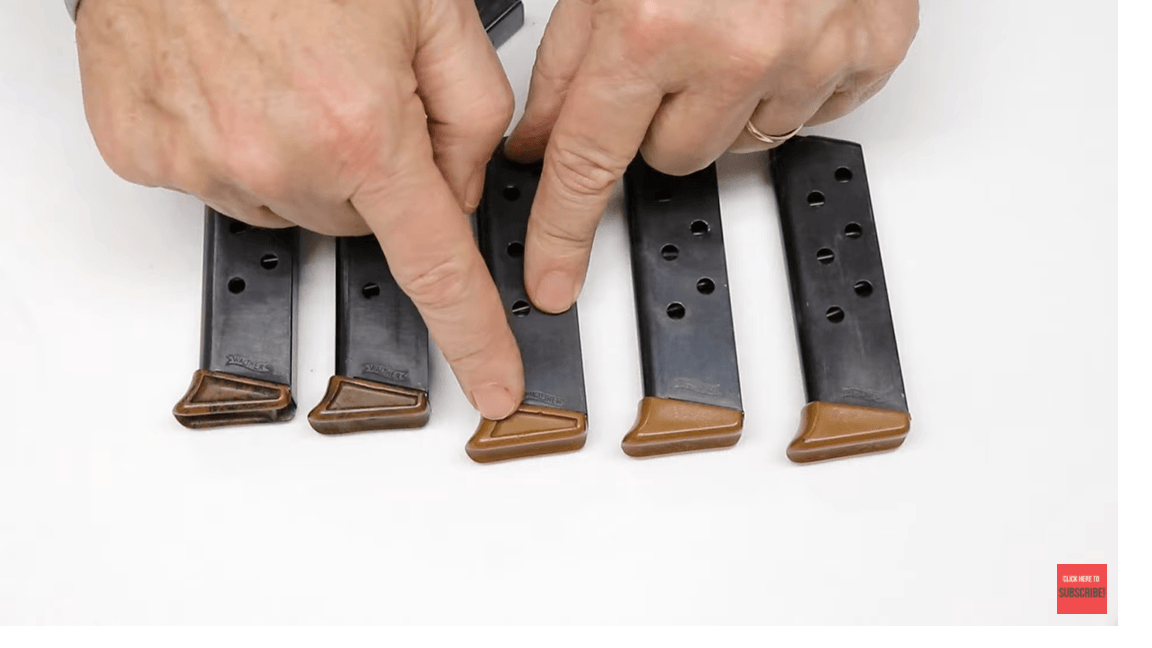
And then it went to a solid color, indented. So you see the indentation, it's a solid color still, there's no lip and it will look like this in the gun. So we have a modelled grip but a solid bottom. People get confused by that because they think maybe it's fake or there's something wrong with it, but there was a very short period of time where they went from this to the modeled bottom that they made a solid bottom indented. Now the time period…this is again 1931, ’32, this is probably ’33.
By 1934 we had the RZM
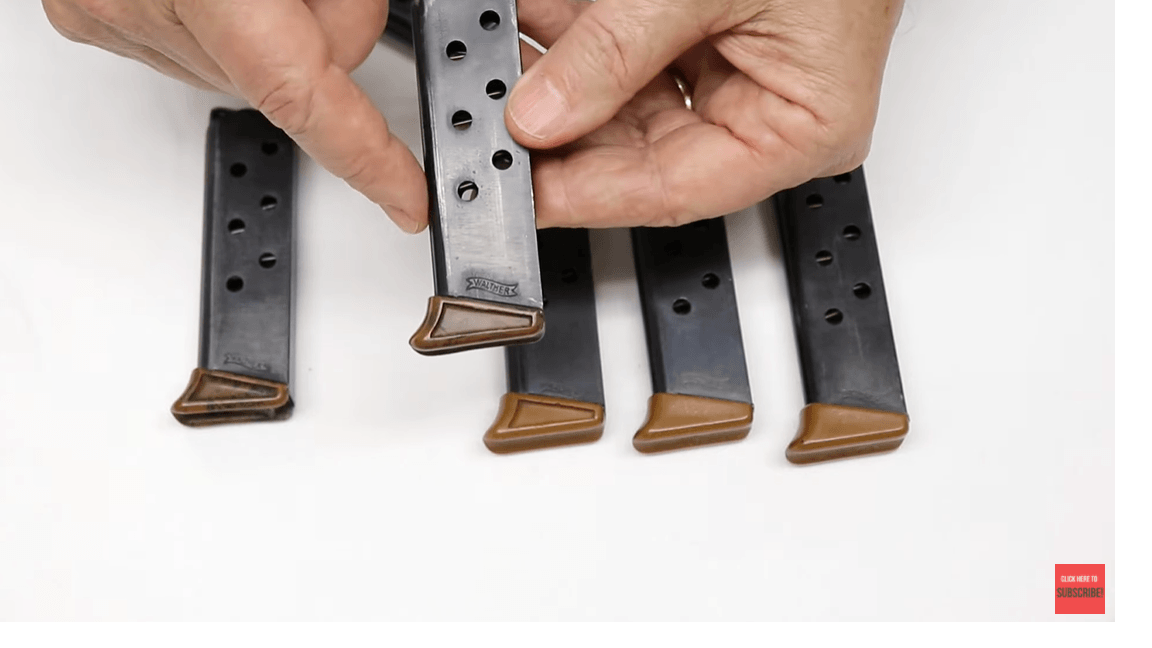
By 1934 and this is remember your RZM PPK came out in ’34, ’35; every RZM that I knew had not been messed with, it came with it a indented side and no lip. So this is the magazine that goes with your RZM and probably all the way up to 1936, probably into 1937 because they didn't throw them away but then they went to the thin lip just like the PPK. We added the thin lip and you can see the difference, no lip and thin lip. And this takes us up to about 1939. So the span is ‘31 - ’39, these are the variations.
SECTION 4 – WARTIME PPK VARIATIONS
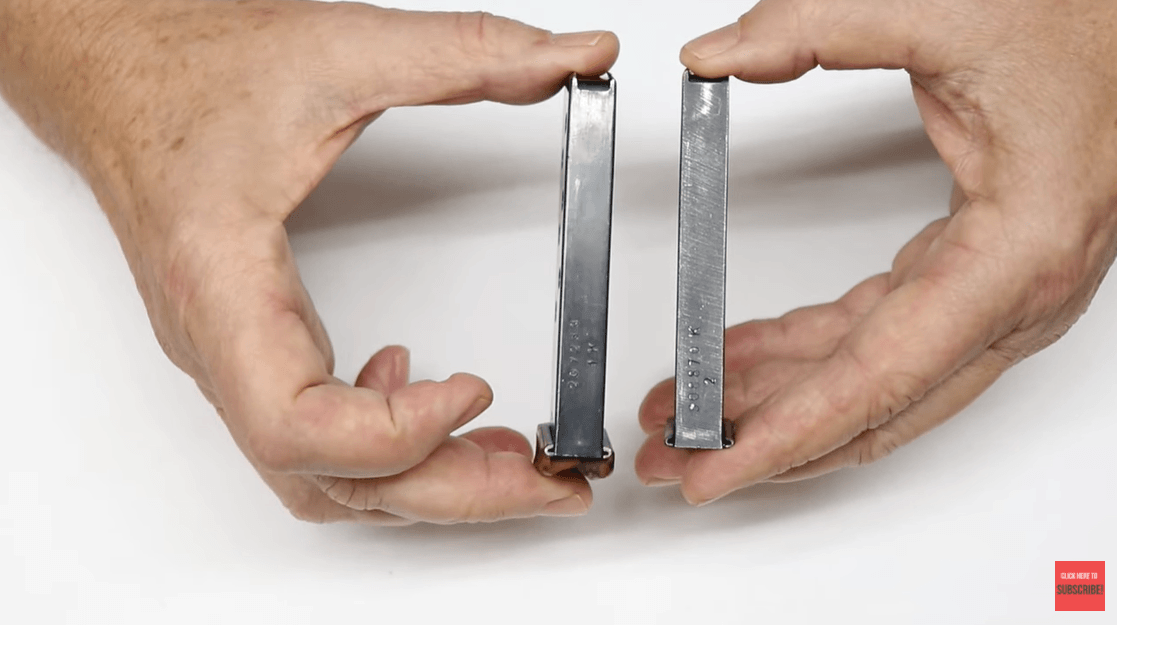
A closer look at the Wartime PPKs
Okay, now we've moved on to the wartime PPK finger extensions. Bear in mind that most of your guns are just going to have a flat bottom. Again military and police are just going to have a flat bottom, notice the high polish, this is dull and that's what you're going to see in most of your guns.
The thick Lip is up first
But when you're looking at the finger extensions we have the modelled thick lip and actually this is 1940, you will still see some thin lip. I don't have one in front of me right now but I do see the caliber and the PPK on the tube with a thin lip. So in 1940 they were still using up the thin lips, they didn't just throw them away but by 1940 they started moving into the thicker lip.
The Color Changed Here
I threw this one in here because the brown went from a tan to a dark brown. Again I'm going to do a separate one on the grips; you can see that the grips become darker and therefore the thick lip, also they make… I call this a chocolate brown versus the mottled brown, it doesn't match exactly, but you can see that it is getting darker notice the difference it's starting to get darker.
The Famous Grey Grip
And then lo and behold you've probably heard of the infamous grey grip, not infamous, you've probably heard of the famous grey grip. Here's one, just came in today. This is brownish grey but that just came in today. And here's a perfect example, absolutely correct, this is a Police Eagle C, has to have a flat bottom. This is a grayish grip - grayish brown grip, get the coloration like that, oh that's even better. Look at that isn't it beautiful and I just happen to have a gray finger extension, thick lip, wartime caliber, does not go with this gun but actually would go nicely with a commercial gun that had a gray grip. Doesn’t that look great? Very, very rare, I've only seen a few of these, so please don't write to me and say can I buy it. I don't want to sell it, I've only had a few.
And then came the Black Grip
And then more commonly, by the time we get to end of 1943 beginning of 1944, we do see the black. Of course by then they're using the black grip in ’43, ‘44 they're using the black grip and always it would come with a black finger extension. Again thick lip, caliber and model. So those are the later war variations.
Here’s my Opinion
Now I also want to prove another point or give evidence of another point. My theory is that they stopped making PPKs in 1944 and they continued with the PP because that was preferred by the troops. But they stopped making the PPK in 1944 which is why you don't get a W mark, you will not find a PPK with a W mark like the 1945 PP. And the quality of the grip and everything, and they still had all the features of the 1944 gun when they stopped making the PPK. So the span of this would be 1940 all the way through to 1944, but not 1945.
SECTION 5 - POSTWAR VARIATIONS
How could I miss this?
Okay so I can't do this video without talking about the post-war differences. I didn't mention that in the introduction but just now realized that I have to tell you about the post-war variations, because people get these confused and there's about $100 difference in the magazine. So that this magazine is a $120 - $140, this magazine is 40 or 50 bucks, so the best way to tell is look at the font.
A Tip to spot the Difference Quickly!

These do have…this does have the caliber and it says PP. It has the Walther banner PP and the caliber, you can see the font right there. But look at this one actually a PPK but the font is a little different. Here's the most important difference. There's no slash if you look at the mm for millimetre; on all of the wartime ones it'll either be Walther banner or it'll have the caliber and there's always a slash (/) in the mm (m/m). And that's the quickest way to tell. When I’m walking a gun show and I see this, I say a post-war, right away. And that drops the price significantly versus the mm.
Another Way to tell it's Post-War
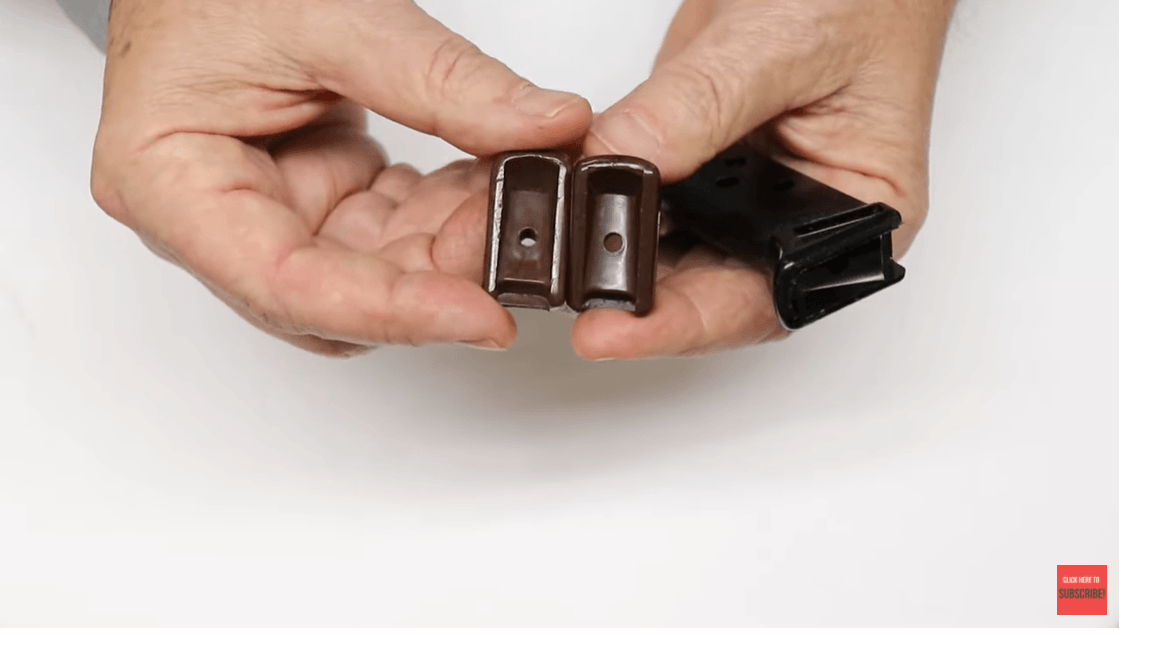
Also the bottom, how do I know that that's a post-war bottom, much harder to tell. I'll be honest a lot of people get it wrong. First of all a lot of them come with the solid brown color and that's easy to spot. The solid brown color these are all post-war and the black would be hard to tell, because here's a black wartime versus this is the black wartime, this is a post-war. The curve right here is a little bit more squared off, this is a little more tapered. It's the only thing I can advise you, is this one there's a little more tapered and rounded, so it's like a halfmoon; this one is more squared off. Is it hard to tell? Absolutely; it's easy to take the bottom off of this and put it on a wartime PP or PPK and it would get past most people, including me.
So you do have to watch out for that. This is post war, this is war time. It's a little easier obviously on the brown, it's easier to see. Here's a brown thick lip versus two post-wars. You can see how this is much more rounded and that's easier to spot. So you might want to study that a bit, but the easiest thing is the mottled color. They didn't do this post-war, they can't really replicate this very well. I've seen the attempts to fake these and they're just not good at all. Same way with the party leader grip, they tried to fake that mottled look and they just can't do it.
SECTION 6 – BOX MAGAZINES
Okay, now let me go over the box mags. There's very few of these that were made, it was a commercial option and they were expensive at the time. So not many people order them and they still are expensive because they're so rare. This is an example of two of them on the gun.
A close up of the Box Mags
The Walther PP, this happens to be a Tyrolean PP. I did a whole video just on the Tyrolean and you can see the box mag fits in here, it does not extend the magazine capacity. So the capacity is 8 with a flat bottom, it's 8 with the finger extension and it's 8 with the box mag. The only thing the box mag does is when you hold, it just gives you a little more room, it does not extend and for that reason it was not a real popular option and they're rarely seen. But if you ever do see a box mag, these sell for about $800. On the PPK they sell more like $1000.
They do fake these Box Mags
And again they would be the mottled brown, they do fake these. You can see here that it matches pretty nicely. They do fake these but they can't get the coloration right. So you usually will see a solid color or a darker brown. This one doesn't match perfectly but this happens to be to a .22 caliber, as is this one, but I've seen just as many on 7.65 guns. And again the capacity here is 7 rounds whether it's flat bottom, finger extension or a box mag, it's still seven rounds.
Now if you happen to be lucky enough to have one of these, don't pop these in real hard because this is a very, very thin lip. You want to be very careful, a thin lip and when you pop it in there you just want to make sure you put it in there gently. Okay that's called the box mag and it was a rare option for commercial guns probably in the 1936 - 1939 time period. Once the war broke out people didn't care about these anymore.
SECTION 7- SPECIALTY MAGAZINES
Okay in our next section, I want to talk about specialty mags. Of the oddest of all the specialty mags, meaning just different colors that are not normal, the two oddest that I know of are the red mag and the green mag.
Green Mags
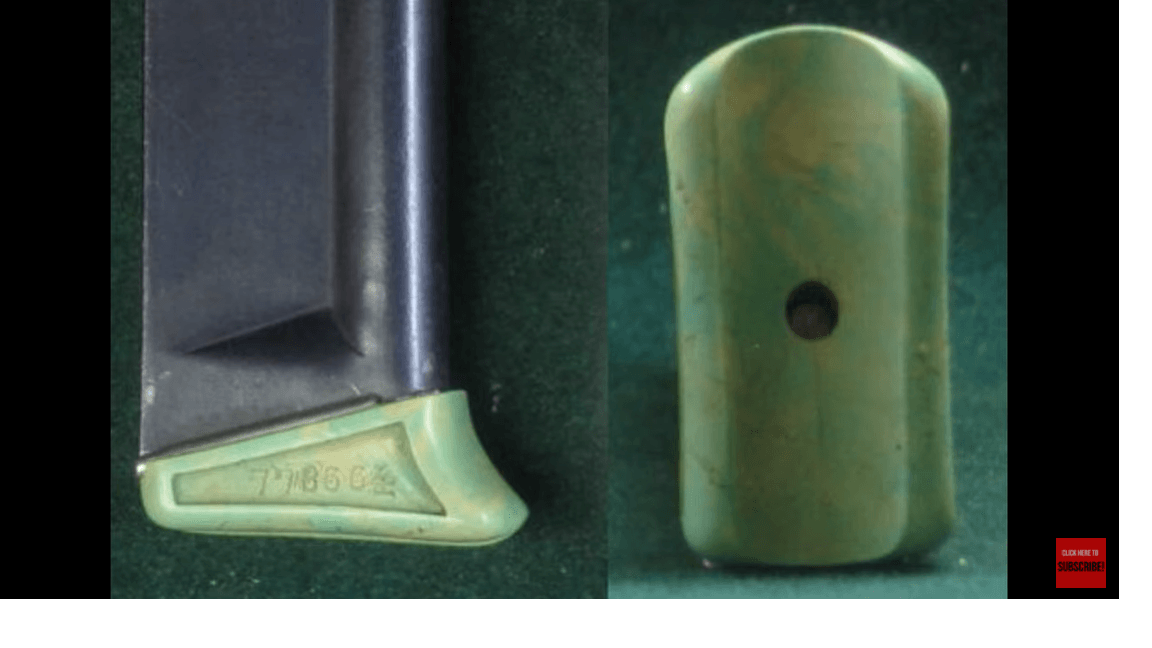
I've had a couple of green mags, I had one recently and thought I would never sell it, but somebody money whipped me, you might know what that means from one of my earlier videos, but I was money whipped to get the green one. Here's a picture of a green one, it's a little faded but most of the green ones I've seen are real bright green, almost like this red where it's a glow-in-the-dark green.
They're all early, some of them are numbered and they all seem to match bank guns - numbered to a bank gun. So the green may have been issued to bank guns, it's just hard to say for sure, I just don't know. Collectors have been talking about it for years, where did they come from? Why did they make them? Nobody really knows it's just the oddest thing. And the same way with the red. Oh before I go to the red bottom, if you happen to have a green bottom and you want to sell it please let me know. I've been looking for one for a long time.
Red Bottom Mags

I do have several of these red bottoms again very odd, very mysterious and most magazine…most mag bottoms come with blued plate. Every red bottom I've ever seen comes on a nickel plate. And this one, the bottom is nickel plated and it's on a nickel plated magazine. Now you'll notice again every red bottom I've seen is slab side, no lip and this one is an open follower. So I have to conclude this was made for a special presentation gun that was nickelled. Very, very early; looks very cool by the way. I have seen a nickled gun with a red bottom and they're very cool-looking. This was just a spare that I picked up at a gun show. The guy didn't know what it was. These can sell for a lot of money and just one other.
Forensics Time
Let's do some forensic on this one. Wartime, uh-oh that doesn't fit. Still silver, or I mean nickel, slab side, no lip, something's amiss. Well the story on this one, a GI in the factory at the end of the war, put them together and brought it home because he thought it was cool. Now that's the only story that makes sense to me. Wartime with a very early, I'm just going to leave it alone, leave it like that but that's just a magazine that I have.
Engraved Guns and White Grips do Exist
Here's another specialty mag, goes to a nickelled gun with a white bottom, there are white grips. I have a lot of engraved, not a lot, I never have enough. I have some engraved guns. Here's a silver engraved, white grip and again special order but it is factory. Comes with an engraved bottom, flat bottom and this magazine. Now you'll see this magazine and silver-plated, thin lip, banner only, thin lip probably made around 1938, ‘39 and you know that because you've been watching my videos.
An Ivory Magazine
And one other, I do have some ivory bottoms. This is like an ivory slab, no lip. So these are just unusual mags. If you come across these don't write them off right away they might be worth a lot of money. But those are just some of the specialty mags that you'll encounter.
SECTION 8 – NUMBERED MAGAZINES
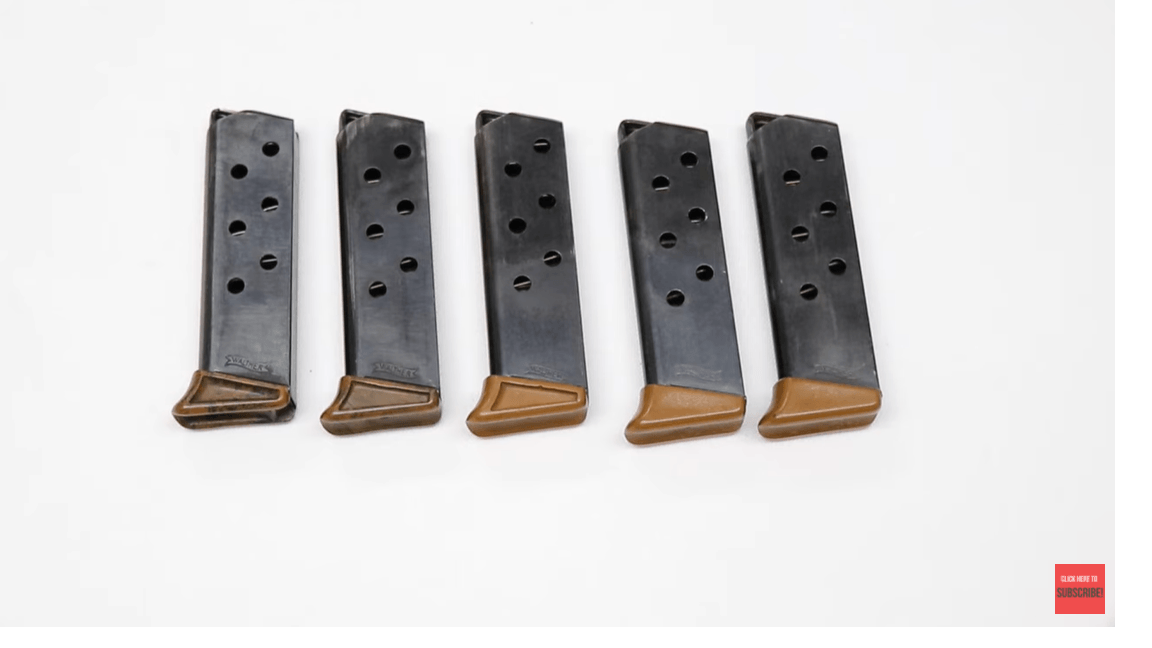
Okay, moving right along. This section is on numbered mags and this is very important because generally, Walther did not number their mags. People with commercial guns contact me and say I'm looking for the matching mag to my gun. They don't exist. Most of the Walther's that were made were not numbered mags.
Sometimes they got a special Contracts
However, they did sometimes number mags by special contract. So if you have a magazine that is numbered to the gun or otherwise numbered, it was probably for a special contract. So the known special contracts that we can talk about is first of all the SS guns. The SS guns were generally, and I'm going to speak in generalities, the SS guns were numbered on the spine. And I'm going to do separate videos on the SS guns but if you have a spine numbered PP or PPK chances are pretty good that it's SS, if it's matching to the gun of course. And I could take this magazine and put it in any gun and I can't call it an SS gun; but if I find the gun to match this then I know I have an SS gun.
We’ll help you match the guns to the Contracts
It's a very complicated process finding out what contract it came from. Obviously you can contact us, we'd be happy to hear from you and if you give me the serials. I keep track of serial and have a growing database, would be happy to help you out. But generally spine numbered are going to be SS guns.
Bank Guns were Sometimes Numbered too
I've already shown you in the other videos, that some of the early guns were numbered here on the finger extension. These are generally bank guns, in fact I don't know any other contract that numbered it here. These were not done at the factory, I believe they were done at the bank arsenal. They are pretty crudely numbered.
Backup to the SS guns for a sec
I should go back to the SS, these are factory numbered magazines. So that's important to note.
The Luftwaffe Contract
And then the only other contract that I want to emphasize now is the Luftwaffe contract. Generally speaking if it's numbered on the bottom of the magazine this gun would be Waffen proofed, indicating it went to the military. But the fact that it has a numbered magazine indicates that it went to the Luftwaffe. Other Waffen proof guns will not have numbered mags, so generally guns that went to the army and I would presume the Navy, although I don't know of any Navy issued guns, any ones that went to the military other than the Luftwaffe did not have numbered mags. But generally the bottom numbered mag is Luftwaffe contract.
This one is a Bit unusual
Here we have one that's kind of unusual because you can see its 9-millimeter, 9-millimetre and two matching mags. I actually have this gun and we'll be doing a separate video on this 9-millimeter Luftwaffe contract gun. So that that's pretty unusual.
Police guns are usually numbered too
Now those are all the factory numbered magazines that I know of, of course I did say this is probably not factory. But there are other guns that are numbered and those are usually police. Generally the magazines that are numbered on the side and sometimes they'll be on the toe, I'll call that the toe. Right here you'll see three digits or you'll see a full number here. These are usually done at the police arsenal and these would be police numbered, not factory numbered. Here's the best way to tell. They're always pounded in there pretty strong, so they look really deep.
And usually there's a dent where they put it in there. Because the magazines were hardened and then they went to the arsenal, and when the Arsenal put them in, they had to pound them in there pretty hard. And so they almost always dent the metal. And so you'll see that on the toe numbered, you'll see a dented metal or it's even bent. This one isn't toe numbered, but these are numbered on the side as compared to the…let's take a look at the factory numbered. They're usually not dented in, they're very light. See it's a very light strike on soft metal versus pounded in after it's been hardened. So these are not factory, they're almost always going to be police and they're almost always going to be numbered on the side of the magazine, and they can be either side. But that's a general overview of the numbered magazines.
SECTION 9 - 9 MM PP AND PPK MAGAZINES
Okay our next variation is going to be the 9-millimetre PP and PPK magazines. This is one of the easiest ones because from the beginning they were all marked 9-millimeter. The early variation has six holes, the later variation only has one. If you turn them over they all have the same holes, but I have no idea why, but early variation and I can't tell you when it changed over, all I know is if you have a 9-millimeter, either one of these magazines would be fine. It's real easy; from the beginning they were always marked 9-millimetre and that's because as I said before 90 something percent were 7.65, so when they made a 9-millimetre they always marked them 9-millimetres.
Other ways to Recognize the 9-Millimeter
The other way to recognize a 9-millimetre, notice the solid follower. We talked about the open follower, this is a 7.65, you can see this is just stamped sheet metal and so there's a gap right here in the metal, stamped sheet metal. In the 9-millimetre it's a solid follower. Maybe that was just as extra reinforcement because the 9-millimetre is more powerful. You can see the solid follower on every one of these, as opposed to the stamped sheet metal, so a little bit stronger.
The 9-millimeter had no Notch
The other thing that you'll notice is there's no notch. Now the notch is for the push-button release. Right here is the notch I'm talking about, and if I look at a 9-millimeter pistol, obviously 9-millimeters, bottom release magazine instead of the push button right here. Now the theory is that the push button, drilling a hole here weakens the frame and again this is a theory, this has been told to me over the years by advanced collectors. The theory was that the push button weakened the frame, so for 9-millimetre they made it a bottom release magazine. And so that that's how you can distinguish that.
There was an Exception Though
Now you can see right here one exception, right here, that one was notched. A good friend of mine, I've never seen one, but a good friend of mine collects 9-millimeters and over the years he has found two 9-millimeters with a push button mag release. Very, very rare gun and I don't know if they ever made a magazine for it because this went to a push button and it looks like somebody cut that in and it was not factory made. So obviously this is a 9-millimetre, somebody cut in the little notch.
Let’s see if you can guess this Variation
One other factory variation, there is a 7.65 that is bottom release. Some of you really smart people could shout it out right now. That's right, the PDM. PDM which is Police Department of Munich, both PP and PPK. It's a 7.65 but it does not have a push button, has a bottom release I have no idea why, but they ordered it with a bottom release and the magazine is not notched. So that's 7.65 without the notch just like the 9-millimetres.
SECTION 10 - .22 CALIBER PP AND PPK MAGAZINE
Okay, continuing along. Now we want to talk about the .22 caliber PP and PPK magazine. I just said that the 9-millimeter was the easiest because they're all marked 9-millimeter, they all have a Walther banner, so it's really easy to tell the 9-millimeters.
Here comes the Challenge
The .22 caliber are by far the hardest because there is no Walther banner on any of them, there's no caliber on any of them. It’s easy to spot a .22 caliber just because it has the distinct formation, it's just very thin. So you can tell the .22 caliber but when there's no marking on it at all, it's very hard to tell if it's aftermarket, if it's post-war.
Let’s start with the Easy Ones
The easiest ones are the early ones. They're seven hole and these were the earliest so in the 30s. They made them with seven hole and if you look closely you can see a two-tone magazine, see that right here. There's a two-tone magazine, I think if I turn it over you can see it even better. See that two-tone magazine, just like the Colt magazines. Actually early Colt magazines had a two-tone. And I think that was from the dipping process. It has a two-tone magazine, seven hole, this is early PP and PPK from the early 30s.
The Transition
Now just before the transition look there's a thin lip, so we know this was about 1938, ’39. By the way the spring, there's no longer a zigzag spring in here, the spring is all loaded right here. And this is the same thing, it's a straight line without the zigzag spring. So it's just a straight spring, straight line. This is from the late 30s probably into 1940, then they added a different follower with a little… There's no button but I think you could put a tool in here and pull it down. But still, no button and now notice the zigzag spring. So when we get into the war-time you can see the zigzag spring, there's a hole here but no button. So I call this the straight line, I call this the no button.
We are nearing the end of the War
And then toward the end of the war I think by 1944 they did have a zigzag with the button. All of the post-war magazines will have the button like this. But to be perfectly honest with you, I have a hard time telling if this is war-time or post-war. It's really hard to tell, people ask me how can you tell I really…lot of times I can't tell the difference, the exact spring with a button.
I do believe they made these late war. The only way that I might be able to tell is on the post-war there is a chrome look to the follower. This one is a little bit duller but it's not fool-proof and so it is very difficult even for me to know which is a post-war, they're not Walther marked, so I would assume somebody has made them since the war. And yet these magazines can easily sell for $150 - $200. So it's a big investment and you want to make sure you know what you're doing. The easiest thing is that buy one of these early ones because then you know for sure that these were made back in the 30s, late 30s and into 1940.
These Mags are available for Sale at Legacy Collectibles
So that's the .22 caliber magazines. If you have questions on those feel free to email me. I'd be happy to help you as much as I can. And I do have…I do sell all of these magazines, if you're looking for a particular magazine we do have them for sale.
SECTION 11 - .25 CALIBER PP AND PPK MAGAZINES
These were very Rare
Okay. If you've lasted this long through this video now you're in for a real treat because most people will never in their life see a .25 caliber PP or PPK. They are so rare, they only made a very few of them. My contention is they were just experimenting in the market to see if they would be popular. These were so rare that all they did was take a 7.65 slide legend and etch in the 6.35. You can see here .25 caliber bore.
All of them I've seen are etched in like that and the numbers are so small, I think there's only about 10 PPKs known and less than that, maybe 5 PPs known. I don't right now have a PP but I do have the PPK. Now just like they didn't have the slide legend, they didn't really have their own magazine, other than they took a PPK magazine, the holes are a little smaller. Here's a regular PPK magazine, the holes are a little smaller. But all they did was take a Model 8, you know there's a .25 caliber Model 8 Walther, they took the magazine from that and they put it inside a PPK magazine.
Let’s pull it Apart
I'm going to pause here for a minute and pull this thing apart because it's a little tricky and I don't want to hurt it because this magazine alone can be $1,200 - $1,500; you just never see them. Here let me show you what I mean, I'm taking this bottom off and underneath of course is the little guide. And look at that teeny spring but what it holds in place is, there it is, see the Walther banner inside there. That's actually a Model 8 magazine, fits just perfectly inside the tube of a PPK magazine. Now the holes are a little smaller but this is generally a PPK tube.PPK tube, holes are a little bit smaller.
Again here's the regular holes and they slide that inside there. So when you feed it in you can see that this is a Model 8 magazine, that's inside of a PPK magazine. I hope that makes sense. But when that fits up in there it feeds just fine. I have seen probably of the ten known, I've seen three or four of them along with two of the PPs. Every one of them has the exact same thing and now that is…it's not welded but it is glued in there or it's soldered, and I'd say that's soldered. That is soldered in there, so it's not coming out. It's in there pretty tight.
This one, if you look at this one, if I took it apart, this is also a Walther 8 inside here; but the holes are bigger and my guess is somebody made this up post-war. Not a bad idea, I mean if I wanted an extra mag I'll never find one. If you contacted me and say I'll pay you $2,000 if you can find me an original .25 caliber mag, I could probably look for the next 5-10 years and not find you one. So somebody made this up, it seems to work just fine but if I took it apart, you'd see that there is a Model 8 magazine inside this PPK magazine, and it would go inside this gun. So that's a .25 caliber, you may never come across one but that's how they made the .25 caliber magazine.
SECTION 12 – HOW DO I SWAP THE BOTTOM?
A closer look at this Magazine
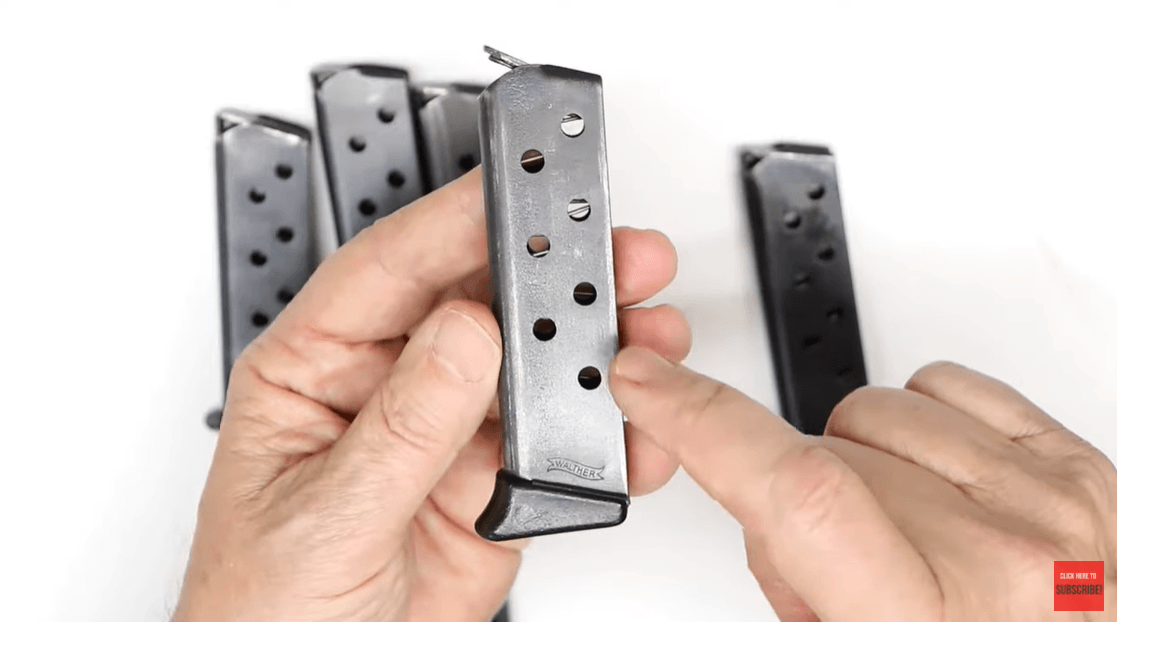
Okay, if you've made it all the way to the end congratulations. Some of you may have fast forwarded it just because all you want to find out is how do I swap out the bottom. Let's say I get this magazine and I'm horrified because it was a Waffen proof gun and should not have a finger extension. Or it was a police gun, let's say it came with a Police Eagle C and I know that it shouldn't have that bottom extension.
I also knew this bottom extension by the way is worth about 200 bucks. So why not salvage it. Also notice this is a Walther banner and a thick lip. If you've been watching this video, you're horrified this is an early tube with a later bottom. So you'll notice this is a dull finish and this is shiny but again if you watch the video, the bottoms were usually high polished because it was the exterior of the gun, this often was a dull finish because it goes interior.
I wonder how Quickly I can swap this Out
But let's see how quickly we can swap this out. I used to use an ice pick all the time, but it does leave a little scratch in there, so…to the ice pick. I got this instead, little paintbrush but you just need a little wooden dowel of some kind, you see the button right there, all you do is push the button in. Now I want to use my thumb like a PEZ dispenser, I'm going to push this in and push my thumb forward. Keep your thumb over the opening because as this comes off, if your thumb is not on there, this will fly up and this piece will hit you in the face.
So this is the guide and the spring, and very quickly the follower falls right out. So that's what it looks like. Follower goes back in, spring goes back in, the guide which is a little bit rusty, maybe when I take it apart I’ll oil it up a little bit, push this down and then you want to hold it down with your thumb. Sometimes it's hard to hold in place, so some people I don't, because I usually do them really quickly, I'll put this through the hole, comes out the other side and that kind of holds it in place a little bit for me. See that, but I often don't bother with that because I'm in a hurry. So I'm going to push this in, I'm going to pull this out, I just hold it like this, again you want to be below the rim, just like George Costanza’s chocolate éclair [47:12-47:13 Video Clip]. As long as it stays below the rim, actually he wanted it above the rim but that's a whole Seinfeld episode you could watch. So I just take this bottom, get it started and hold this down as long as you can push it and then it'll pop in place. You just heard it click.
A Quick Replay
Let me do that again really quickly, push this down, pull this off, keep your thumb over it don't get hit in the face, pulls off, hold it down below the rim, pop it back on again and it pops into place. Okay.
I hope you learned Something! Please subscribe to our email list!
I hope you learned a lot from this video. It took a while for me to make and a while for you to watch, but I hope it's been worthwhile.
Thanks for watching!
Make sure you like and subscribe and share with somebody else who might need help with their PP or PPK magazine.
